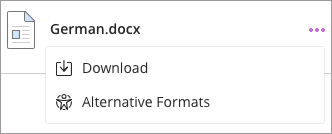Accessibility matters
We’re committed to fostering an inclusive educational environment for students with disabilities. Discover how we work to address disability-related challenges and empower every learner.
Accessibility matters
We’re committed to fostering an inclusive educational environment for students with disabilities. Discover how we work to address disability-related challenges and empower every learner.
Our accessibility policy
The University will develop, procure, maintain and use information and communication technology that ensure people with disabilities have comparable access to them.
All new or modified online content and functionality, including the education platform features, will be accessible to people with disabilities as measured by conformance to the benchmark standards set forth below, except where doing so would impose a fundamental alteration or undue burden.
In the event of a fundamental alteration or undue burden, the University will nevertheless provide equally effective alternate access. Alternate access will ensure, to the maximum extent possible, that persons with disabilities are afforded an equal opportunity to obtain the same result, to gain the same benefit, or to reach the same level of achievement, in the most integrated setting appropriate to the person’s needs. The University is committed to provide information where you can perceive, operate and understand.
Resolution agreement
Regarding assistive technology
University of Phoenix and the U.S. Department of Education’s Office for Civil Rights (OCR) entered into a Resolution Agreement under which the University reaffirms its commitment to ensure independent and equal access to its programs, benefits and services for all students.
A link to the Resolution Agreement (PDF 310KB) is provided.
Accessiblity tools
University of Phoenix offers Blackboard Ally (YouTube) in the classroom. Ally is an accessibility tool that allows faculty to evaluate the accessibility of documents shared in the classroom and provides alternative formats of those documents for students.
Contact us
We’re here to support you and help you achieve your educational goals. If you’d like to learn more about what we do or talk about managing your disability and potential accommodations, please reach out to a member of our team.


For help troubleshooting accessibility issues, call the University's Assistive-Technology Technical Assistive Center (TAC) at (866) 842-5222. Assistance is available 5am-1am every day. You may also reach out to the Student Accommodations Office via phone or email using the contact buttons above.

